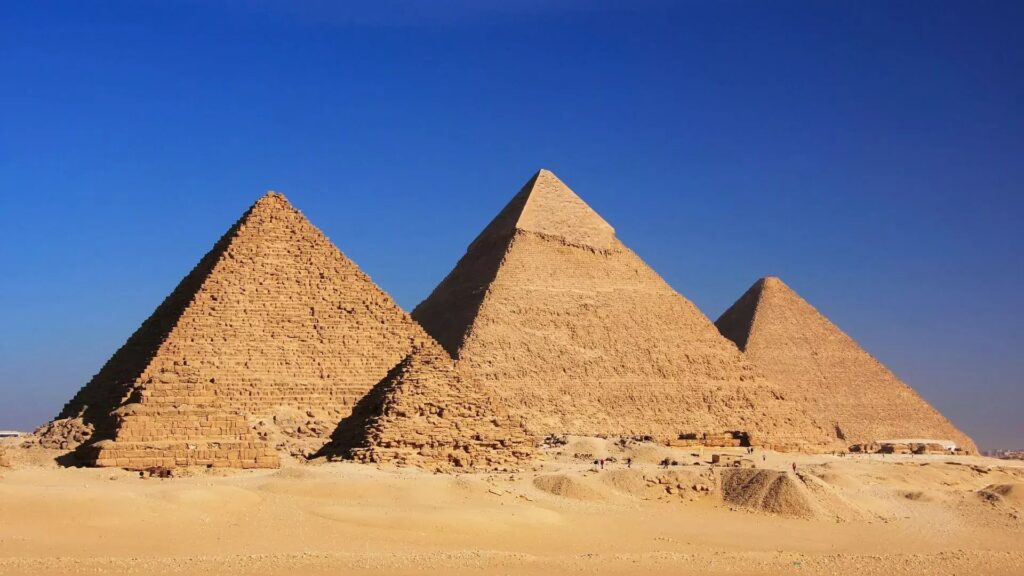4,000-year-old mystery solved: How the Giza Pyramids were built

4,000-year-old mystery solved: How the Giza Pyramids were built
Scientists have discovered a long-buried branch of the Nile river that once flowed alongside more than 30 pyramids in Egypt, potentially solving the mystery of how ancient Egyptians transported the massive stone blocks to build the famous monuments.

The 64-kilometre-long river branch, which ran by the iconic Giza pyramid complex among other wonders, was hidden under desert and farmland for millennia, according to a study revealing the find on Thursday.
The existence of the river would explain why the 31 pyramids were built in a chain along a now inhospitable desert strip in the Nile Valley between 4,700 and 3,700 years ago.
The strip near the ancient Egyptian capital of Memphis includes the Great Pyramid of Giza – the only surviving structure of the seven wonders of the ancient world – as well as the Khafre, Cheops and Mykerinos pyramids.
Archaeologists had long thought that ancient Egyptians must have used a nearby waterway to move the giant materials used to build the pyramids.
“But nobody was certain of the location, the shape, the size or proximity of this mega waterway to the actual pyramids site,” lead study author Eman Ghoneim of the University of North Carolina Wilmington in the United States told AFP.
The international team of researchers used radar satellite imagery to map the river branch, which they called Ahramat – “pyramids” in Arabic.
Radar gave them the “unique ability to penetrate the sand surface and produce images of hidden features including buried rivers and ancient structures,” Ghoneim said.
Surveys in the field and cores of sediment from the site confirmed the presence of the river, according to the study in the journal Communications Earth & Environment.
The once mighty river was increasingly covered in sand, potentially starting during a major drought around 4,200 years ago, the scientists suggested.
The great pyramid mystery
The Giza pyramids stood on a plateau roughly a kilometre from the banks of the river.
Many of the pyramids had a “ceremonial raised walkway” which ran alongside the river before ending at the Valley Temples which served as harbours, Ghoneim said.
This indicates that the river played “a key role in the transportation of the enormous building materials and workmen needed for the pyramid’s construction,” she added.
 The water course of the ancient Ahramat Branch borders a large number of pyramids dating from the Old Kingdom to the Second Intermediate Period, spanning between the Third Dynasty and the Thirteenth Dynasty. (Eman Ghoneim)
The water course of the ancient Ahramat Branch borders a large number of pyramids dating from the Old Kingdom to the Second Intermediate Period, spanning between the Third Dynasty and the Thirteenth Dynasty. (Eman Ghoneim)
Exactly how ancient Egyptians managed to build such huge and long-standing structures has been one of history’s great mysteries.
These heavy materials, most of which were from the south, “would have been much easier to float down the river” than transport over land, study co-author Suzanne Onstine of the University of Memphis in the US state of Tennessee told AFP.
The banks of the rivers could have been where the funeral entourages of pharaohs were received before their bodies were moved to their “final burial place within the pyramid,” she suggested.
The river may also indicate why the pyramids were built in different spots.
“The water’s course and its volume changed over time, so fourth dynasty kings had to make different choices than 12th dynasty kings,” she said.
“The discovery reminded me about the intimate connection between geography, climate, environment and human behaviour.”
News
The Hanging Temple: China’s 1,500-Year-Old Cliffside Marvel of Faith and Engineering
The Hanging Temple: China’s 1,500-Year-Old Cliffside Marvel of Faith and Engineering Perched precariously on the cliffs of Mount Heng in Shanxi Province, China, the Hanging Temple, also known as Xuankong Temple, Hengshan Hanging Temple, or Hanging Monastery, is an architectural…
The Willendorf Venus: A 30,000-Year-Old Masterpiece Reveals Astonishing Secrets
The Willendorf Venus: A 30,000-Year-Old Masterpiece Reveals Astonishing Secrets The “Willendorf Venus” stands as one of the most revered archaeological treasures from the Upper Paleolithic era. Discovered in 1908 by scientist Johann Veran near Willendorf, Austria, this small yet profound…
Unveiling the Maya: Hallucinogens and Rituals Beneath the Yucatán Ball Courts
Unveiling the Maya: Hallucinogens and Rituals Beneath the Yucatán Ball Courts New archaeological research has uncovered intriguing insights into the ritual practices of the ancient Maya civilization. The focus of this study is a ceremonial offering found beneath the sediment…
Uncovering the Oldest Agricultural Machine: The Threshing Sledge’s Neolithic Origins
Uncovering the Oldest Agricultural Machine: The Threshing Sledge’s Neolithic Origins The history of agricultural innovation is a fascinating journey that spans thousands of years, and one of the earliest known agricultural machines is the threshing sledge. Recently, a groundbreaking study…
Nara’s Ancient Sword: A 1,600-Year-Old Protector Against Evil Spirits
Nara’s Ancient Sword: A 1,600-Year-Old Protector Against Evil Spirits In a remarkable discovery that has captured the attention of archaeologists and historians alike, a 7.5-foot-long iron sword was unearthed from a 1,600-year-old burial mound in Nara, Japan. This oversized weapon,…
The Inflatable Plane, Dropped Behind the Lines for Downed Pilots
Experimental The Inflatable Plane, Dropped Behind the Lines for Downed Pilots The Inflatoplane from Goodyear was an unconventional aircraft developed by the Goodyear Aircraft Company, a branch of the renowned Goodyear Tire and Rubber Company, also famed for the Goodyear…
End of content
No more pages to load











